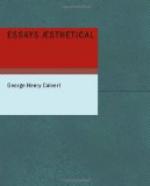Attempts to give a notion of what the beautiful is, by enumerating some of the physical conditions that are found to be present in artistic figures or persons distinguished for beauty, or attempts to produce what shall be beautiful, by complying with these conditions, come no nearer to the aim than do compounded mineral waters to the briskness and flavor of a fresh draught from the original spring. In the analysis there may be no flaw; the ingredients are chemically identical in quality and proportion; but the nameless, inimitable, inscrutable life is wanting: the mixing has been done by a mechanical, not by a creative hand. Haydon says, “The curve of the circle is excess, the straight line is deficiency, the ellipsis is the degree between, and that curve, added to or united with proportion, regulates the form and features of a perfect woman.” Mr. D.R. Hay, in a series of books, professes to have discovered the principles of beauty in the law of harmonic ratio, without, however, “pretending,” as he modestly and wisely declares, “to give rules for that kind of beauty which genius alone can produce in high art.” The discovery of Mr. Hay is curious and fascinating, and, like the announcement of Haydon, may give practical hints to artists and others. But no intellectual process or ingenuity can make up for the absence of emotional warmth and refined selection. “Beauty, the foe of excess and vacuity, blooms, like genius, in the equilibrium of all the forces,” says Jean Paul. “Beauty,” says Hemsterhuis, “is the product of the greatest number of ideas in the shortest time,” which is like the Italian definition, il piu nel uno, unity in multiplicity, believed by Coleridge to contain the principle of beauty. On another page of the “Table Talk” Coleridge is made to say, “You are wrong in resolving beauty into expression or interest; it is quite distinct; indeed, it is opposite, although not contrary. Beauty is an immediate presence, between which and the beholder nihil est. It is always one and tranquil; whereas the interesting always disturbs and is disturbed.” Hegel, in his “AEsthetic,” defines natural beauty to be “the idea as immediate unity, in so far as this unity is visible in sensuous reality.”




